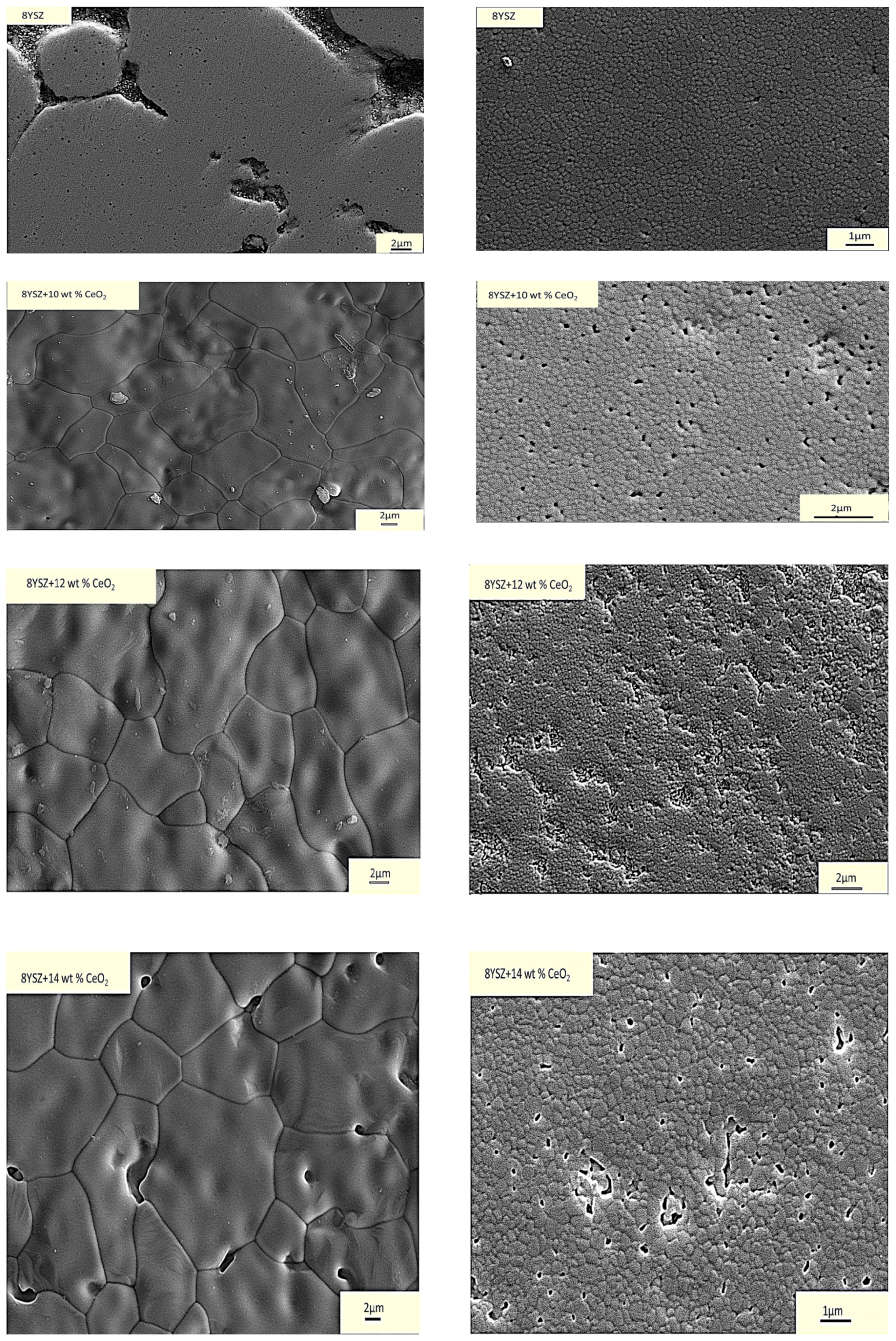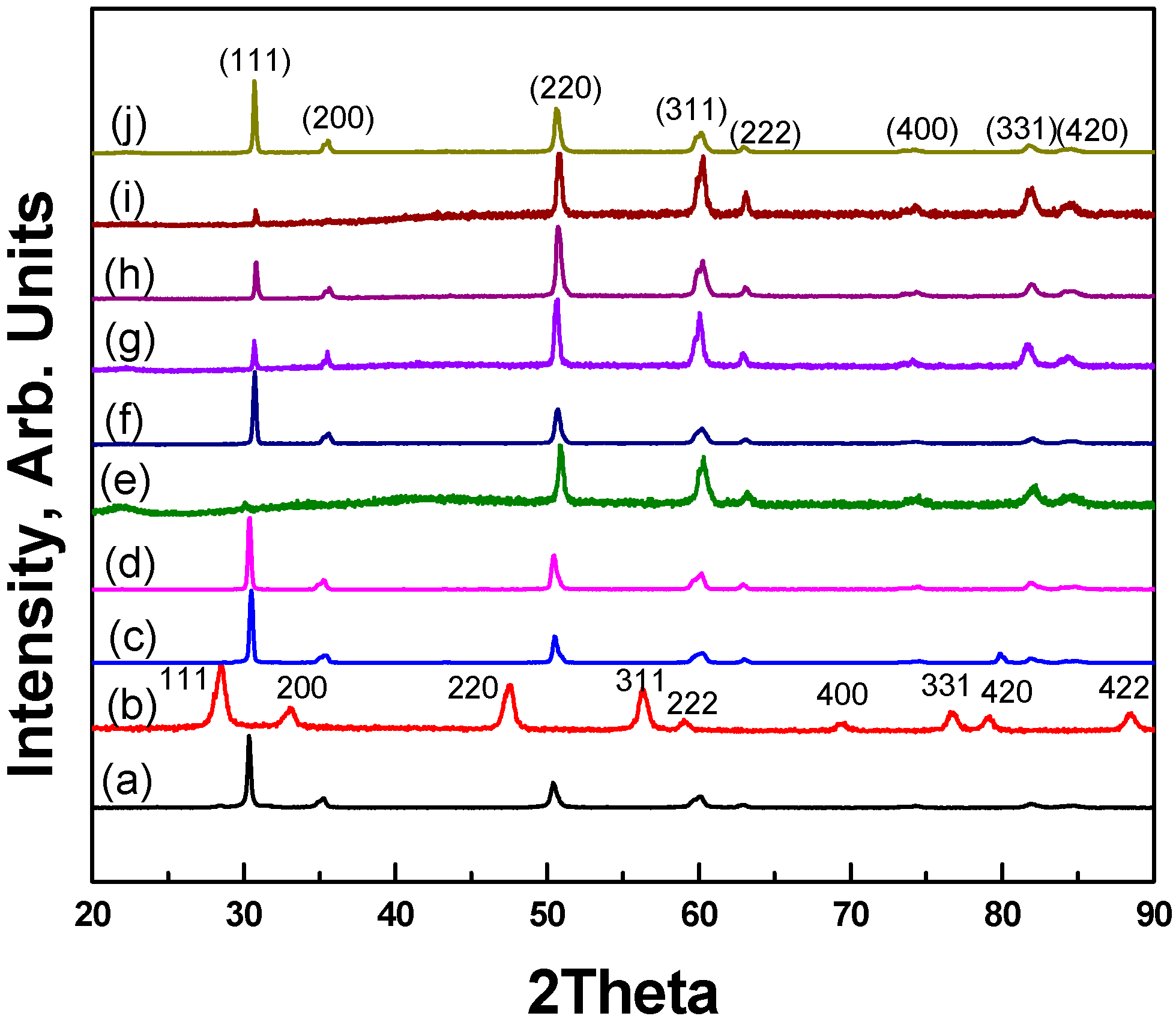Effect of Heating Mode on Sinterability of YSZ+CeO2 Ceramics
Abstract
:1. Introduction
2. Experimental Details
3. Results and Discussion
3.1. Densification and Hardness
3.2. Microstructural Study and Phase Analysis
4. Conclusions
- The sintered densities of 8YSZ specimens increased with the addition of CeO2 content, irrespective of the sintering technique.
- Additions of CeO2 have not disturbed the stability of the cubic crystal structure of 8YSZ.
- The CeO2 acts as grain growth inhibitor, grain size of the 8YSZ specimens decreases with the addition of CeO2.
- The Vickers hardness of the 8YSZ+CeO2 ceramics increased with the addition of CeO2 content.
- The enhancement in sintered densities and hardness values with the addition of ceria were more pronounced in microwave sintered samples than in the conventional method.
Acknowledgments
Author Contributions
Conflicts of Interest
References
- Janney, M.A.; Kimrey, H.D. Diffusion-controlled processes in microwave-fired oxide ceramics. Mrs Proc. 1990, 189, 215. [Google Scholar] [CrossRef]
- Mazaheri, M.; Zahedi, A.M.; Hejazi, M.M. Processing of nanocrystalline 8 mol % yttria-stabilized zirconia by conventional microwave-assisted and two-step sintering. Mater. Sci. Eng. A 2008, 492, 261–267. [Google Scholar] [CrossRef]
- Wang, J.; Binner, J.; Vaidhyanathan, B. Evidence for the microwave effect during hybrid sintering. J. Am. Ceram. Soc. 2006, 89, 1977–1984. [Google Scholar] [CrossRef]
- Nightingale, S.A.; Dunne, D.P.; Worner, H.K. Sintering and grain growth of 3 mol % yttria zirconia in a microwave field. J. Mater. Sci. 1996, 31, 5039–5043. [Google Scholar] [CrossRef]
- Xie, Z.; Wang, C.; Fan, X.; Huang, Y. Microwave processing and properties of Ce-Y-ZrO2 ceramics with 2.45 GHz irradiation. Mater. Lett. 1999, 38, 190–196. [Google Scholar] [CrossRef]
- Wilson, J.; Kunz, S.M. Microwave sintering of partially stabilized zirconia. J. Am. Ceram. Soc. 1988, 71, C40–C41. [Google Scholar] [CrossRef]
- Borrell, A.; Salvador, M.D.; Penaranda Foix, F.L.; Catala-Civera, J.M. Microwave Sintering of Zirconia Materials: Mechanical and Microstructural Properties. Int. J. Appl. Ceram. Technol. 2013, 10, 313–320. [Google Scholar] [CrossRef]
- Idemitsu, K.; Arima, T.; Inagaki, Y.; Torikai, S.; Pouchon, M.A. Manufacturing of zirconia microspheres doped with Erbia, Yttria and Ceria by internal gelation process as a part of a cermet fuel. J. Nucl. Mater. 2003, 319, 31–36. [Google Scholar] [CrossRef]
- Yilmaz, A.E.; Sahin, F.; Yucel, O.; Groller, G. Effect of CeO2 addition on densification and microstructure of Al2O3–YSZ composites. Ceram. Int. 2011, 37, 3273–3280. [Google Scholar]
- Zhao, C.; Vleugels, J.; Groffils, C.; Luypaert, P.J.; Van Der Biest, O. Hybrid sintering with a tubular susceptor in a cylindrical single-mode microwave furnace. Acta Mater. 2000, 48, 3795–3801. [Google Scholar] [CrossRef]
- Li, L.; Van der Biest, O.; Wang, P.L.; Vleugels, J.; Chen, W.W.; Huang, S.G. Estimation of the phase diagram for the ZrO2-Y2O3-CeO2 system. J. Eur. Ceram. Soc. 2001, 21, 2903–2910. [Google Scholar] [CrossRef]
- Lin, J.D.; Duh, J.G. Fracture toughness and hardness of ceria- and yttria-doped tetragonal zirconia ceramics. Mater. Chem. Phys. 2003, 78, 253–261. [Google Scholar] [CrossRef]
- Kim, G.; Vohs, J.M.; Gorte, R.J. Enhanced reducibility of ceria–YSZ composites in solid oxide electrodes. J. Mater. Chem. 2008, 18, 2386–2390. [Google Scholar] [CrossRef]
- Bekale, V.M.; Legros, C.; Haut, C.; Sattonnay, G.; Huntz, A. Processing and microstructure characterization of ceria doped yttria-stabilized zirconia powder and ceramics. Solid State Ion. 2006, 177, 3339–3347. [Google Scholar]
- Samuels, J.; Brandon, R. Effect of Composition on the Enhanced Microwave Sintering of Alumina-Based Ceramic Composites. J. Mater. Sci. 1992, 27, 3259–3265. [Google Scholar] [CrossRef]
- Meek, T.T.; Holcomb, C.E.; Dykes, N. Microwave sintering of some oxide materials using sintering aids. J. Mater. Sci. Lett. 1987, 6, 1060–1062. [Google Scholar] [CrossRef]
- Swain, B.S. Effect of Sintering Atmosphere on the Property of Ceria Doped Tetragonal Zirconia Polycrystals (Ce-TZP). Master’s Thesis, Department of Metallurgical and Material Engineering, NIT Rourkela, Odisha, India, May 2007. [Google Scholar]
- Gan, X.; Yu, Z.; Yuan, K.; Xu, C.; Zhang, G.; Wang, X.; Zhu, L.; Xu, D. Effects of cerium addition on the microstructure, mechanical properties and thermal conductivity of YSZ fibers. Ceram. Int. 2018, 44, 7077–7083. [Google Scholar] [CrossRef]
- Lucas, T.J.; Lawson, N.C.; Janowski, G.M.; Burgess, J.O. Effect of grain size on the monoclinic transformation, hardness, roughness, and modulus of aged partially stabilized zirconia. Dent. Mater. 2015, 31, 1487–1492. [Google Scholar] [CrossRef] [PubMed]
- Moshtaghioun, B.M.; Gomez-Garcia, D.; Dominguez-Rodriguez, A.; Todd, R.I. Grain size dependence of hardness and fracture toughness in pure near fully-dense boron carbide ceramics. J. Eur. Ceram. Soc. 2016, 36, 1829–1834. [Google Scholar] [CrossRef]
- Clark, D.E.; Sutton, W.H. Microwave processing of materials. Annu. Rev. Mater. Sci. 1996, 26, 299–331. [Google Scholar] [CrossRef]
- Guo, C.X.; Wang, J.X.; He, C.R.; Wang, W.G. Effect of alumina on the properties of ceria and scandia co-doped zirconia for electrolyte-supported SOFC. Ceram. Int. 2013, 39, 9575–9582. [Google Scholar] [CrossRef]
- Nightingale, S.A. Sintering of Yttria Doped Zirconia Ceramics in Microwave Field. Ph.D. Thesis, Department of Materials Engineering, University of Wollongong, Wollongong, Australia, May 1995. [Google Scholar]



| Composition | Sintering Mode | Relative Density | Theoretical Density (g/cc) | Grain Size (µm) | Vickers Hardness (Hv500) |
|---|---|---|---|---|---|
| 8 mol % YSZ | CS 1400—5 h | 85 ± 1.81 | 6.09 | 10 ± 2 | 1136 ± 8 |
| MW 1400—20 min | 92.2 ± 0.41 | 0.27 ± 0.01 | 1312 ± 15 | ||
| 10CeO2 + 8 mol % YSZ | CS 1400—5 h | 85.44 ± 1.86 | 6.194 | 6.25 ± 1.03 | 1188 ± 20 |
| MW 1400—20 min | 93.2 ± 0.32 | 0.24 ± 0.1 | 1349 ± 21 | ||
| 12CeO2 + 8 mol % YSZ | CS 1400—5 h | 86.33 ± 2.42 | 6.2148 | 5.82 ± 0.2 | 1232 ± 8 |
| MW 1400—20 min | 95.1 ± 0.45 | 0.22 ± 0.02 | 1364 ± 16 | ||
| 14CeO2 + 8 mol % YSZ | CS 1400—5 h | 88.53 ± 0.92 | 6.2356 | 5.5 ± 0.55 | 1295 ± 15 |
| MW 1400—20 min | 96.2 ± 0.42 | 0.19 ± 0.01 | 1375 ± 9 |
© 2018 by the authors. Licensee MDPI, Basel, Switzerland. This article is an open access article distributed under the terms and conditions of the Creative Commons Attribution (CC BY) license (http://creativecommons.org/licenses/by/4.0/).
Share and Cite
Raja Annamalai, A.; Nagaraju, N.; Agrawal, D.K.; Muthuchamy, A. Effect of Heating Mode on Sinterability of YSZ+CeO2 Ceramics. Metals 2018, 8, 189. https://doi.org/10.3390/met8030189
Raja Annamalai A, Nagaraju N, Agrawal DK, Muthuchamy A. Effect of Heating Mode on Sinterability of YSZ+CeO2 Ceramics. Metals. 2018; 8(3):189. https://doi.org/10.3390/met8030189
Chicago/Turabian StyleRaja Annamalai, A., Nidhi Nagaraju, Dinesh K. Agrawal, and A. Muthuchamy. 2018. "Effect of Heating Mode on Sinterability of YSZ+CeO2 Ceramics" Metals 8, no. 3: 189. https://doi.org/10.3390/met8030189





